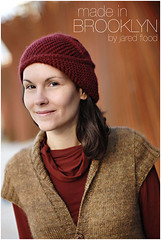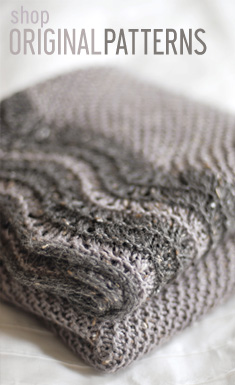8.13.2009
Made in Brooklyn | Sweaters for Her
More sweaters today - this time for the ladies!
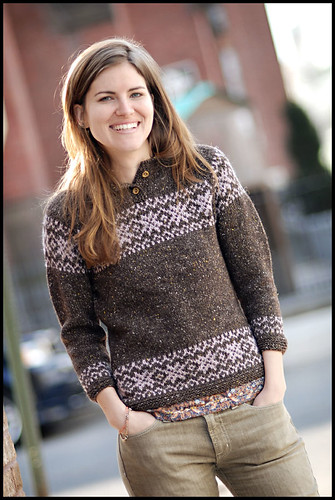
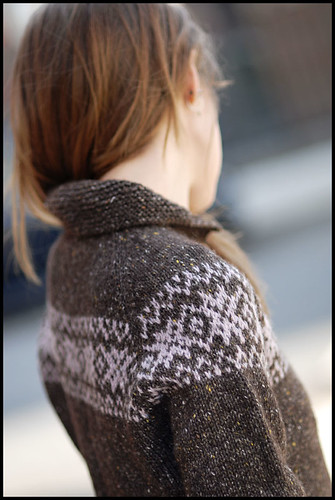
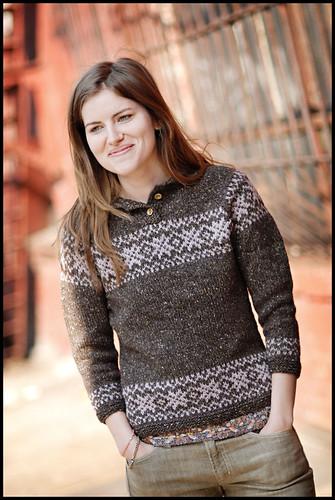
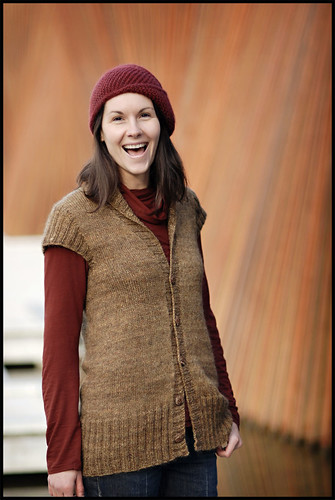
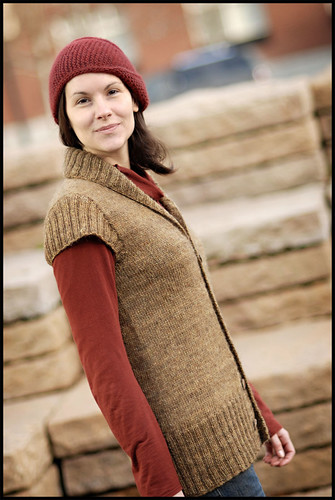
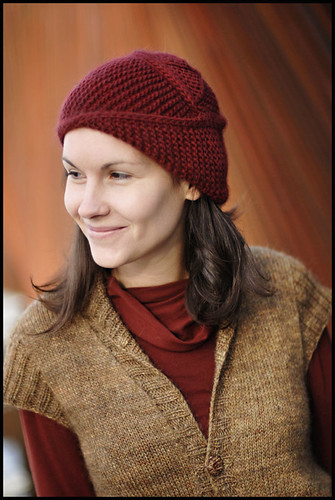
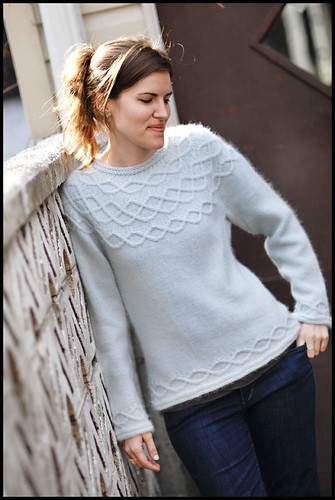
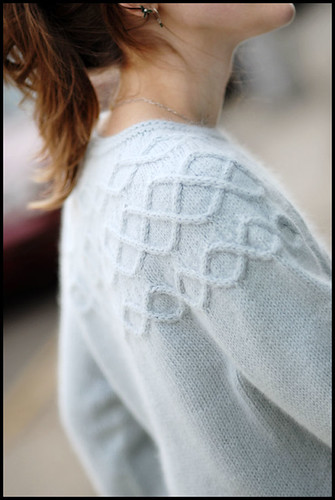

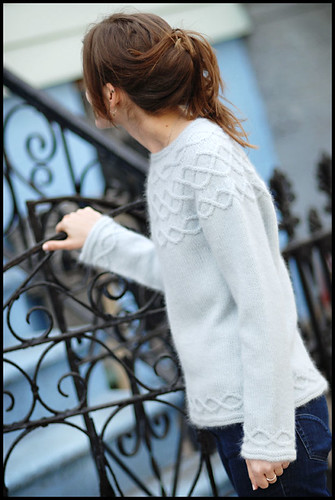
OH! Before we get in to that, though, I wanted to remember to mention this: although MiB's sweaters may be written out for men or women, I encourage everyone to experiment! Sometimes the only difference between a men's sweater and a women's sweater is the presence of waist shaping and some simple proportion changes (like yoke depth, arm/body length). If you've fallen for a specific design but it's for the wrong gender, please feel free to use the pattern as a guide: take measurements off of a sweater you love (and whose fit you agree with) and go for it! And with that brief soap-box moment out of the way, I present the sweaters:
Meet Stilwell.

More colorwork. More tweed. When I first got the colorcard for Portland Tweed, I was playing with a lot of combos and this one kept coming back to me as something I'd like to knit with. A rich, chocolaty brown coupled with a very dusty, subtle, almost grey (my favorite adjectives for almost any color) shade of pink.
It's a good old fashioned seamless raglan ("If it ain't broke, don't fix it" comes to mind) with some colorwork detailing on the yokes and cuffs. I wanted to do a bit of mixing and matching of styles with traditional Norwegian star motifs and more contemporary elements like a fitted body, 3 quarter length sleeves and shaped collar.

The piece is worked with a henley neck as well. For colorwork patterns, I instruct knitters to use one needle size for one-color stockinette portions, and a larger needle size (2 or 3 sizes up, whatever gets you correct gauge) for all colorwork portions. This is necessary to obtain the same stitch gauge between two different fabrics within one garment. Row gauge is significantly different in colorwork, but that's been accounted for in the design, so stitch gauge is the key - in this way the tension in the fabric is kept constant throughout.

I remember knitting a colorwork yoke sweater from a pattern years ago, all with the same needle size, and how the tension change in the yoke drove me crazy. I've since been experimenting with ways of never making that happen again. This works for me! Anyway - I guess what I'm trying to say is, to save time and frustration when knitting projects with both one-color and two-color stockinette portions, find what gets you the same stitch gauge for each and use those two needle sizes for best results.
Tangents! Tangents! Ahem.
Meet Redhook.

One of the reasons I love Fall so much is the prevalence of layering. People are rocking the layered look everywhere you look and that makes for interesting and inspiring style, not to mention a good way to mix up a wardrobe that can start to feel reeeeaally boring after all those stifling summer months of wearing one thing at a time. Layering is all about contrast: long and short garments, fabric weights and warmths, and maybe most importantly, color! So with all of that in mind, Redhook was conceived as a fun monkey wrench to throw into your layering mix. Vests in general are great for this type of thing because they can be worn under outerwear with no bulk at the arms, and less overheating.
I wanted a garment that could be worn as a stand-alone, or layered easily, had a simple shape and a couple of nice details - like a luxurious collar! I can't get enough of those.

I also fell in love with this color. Moorland is a single-ply heathered yarn that comes in a wonderful group of earthtones (very, very hard to make color decisions on this one). The thing that really floored me about the yarn was the drape after washing - it got super silky and smooth, and very much took me by surprise after I picked it up off the blocking board (who am I kidding, the carpet of a guest room in Portland, Oregon). It was warm and light, and even more perfect for pairing with other clothes. Bonus points!

Redhook involves lots of fun with short-rows. Both sleeve caps and shawl collar/buttonband are all worked directly off of the body fabric from picked-up sts and shaped with short rows.
And finally, Seneca.

Sometimes, scratch that, most times, design ideas hit you at the oddest times. Like when you're sitting, twitching, in jury duty (which makes it even more unbearable, as you're already thinking about how much you'd rather be at home knitting). I had been wanting to knit a rounded yoke pullover with cables that weren't vertical, and desperately wanted to keep it all in one piece. I had been chewing on that idea until BAM! Jury duty brought me to sideways cables.

Sideways cables are interesting - if you've never worked them, here's how they roll: They seem as if to appear out of nowhere on a stockinette or reverse stockinette background. This occurs by a severe increase, usually 5 stitches into one and working the cable directly from that point. When the cable is done, you use a fancy 5-to-1 decrease and you're back to your stockinette fabric. They're like little intermissions from your mindless stockinette meditation.
AND - they perfectly suit round yoke sweaters, which are shaped with intermittent decrease rings throughout the yoke - in Seneca, they're stashed between cable motifs, so that the stitch counts are never interrupted when cabling, which is a major sigh of relief.

A note before I forget about this one: Because of the rather dramatic nature of the fabric manipulation - the severe increasing for the cables and severe decreasing for the round yoke - you'll definitely want to do an official blocking job (I really recommend full-immersion for this) to smooth all of that out after completion. Sweater fabric always looks better after this process, (always) but this sweater benefits from it especially.
Sidways cables are also thrown in on the cuffs for a little extra interest and weight there. Because the sweater is a worsted weight fabric, I generally advise about 3-5" of ease for a classic fit. My model was about 5-6" smaller than the garment and liked the cozy feeling of a little ease added in. I'm a big fan of a little room in my sweaters, especially in warmer fibers like angora.

That rounds out the sweater portion of this tour. Stay tuned for the last two stragglers from the booklet in the next couple of days.
____________________________________________
RAVELRY Links
Stilwell on Ravelry
Redhook on Ravelry
Seneca on Ravelry (Also available as an individual PDF download)
Comments:
Beautiful. I can't wait to get these patterns. I loe Seneca, but have some tweed yarn that wants to become Stilwell first.
Patsy
I can't wait to see the book in person.
Here's to many sales and editions. Cheers!
Do you know whether anywhere in Europe will be distributing the book? CEY's website say they won't ship overseas - boo hoo, boo hoo! I'm an impatient person, I confess, and Spring is a long time away to wait for downloads.
Feeling the book before holding him in my hands.
It is like smelling worm bread in the morning. A gift... thanks for sharing!
I loved the color combination on Stilwell. The length and the way it fits on the body are perfect.
Redhook is a must have! So smart and versatile! He and Quincy love each other, ha?!
And Seneca... with those sideways cables!!! Won-der-ful.
You are genius!
- Beth
I read your interview in Yarn Market News this morning and my hat is off to you. I have always respected your work a lot, but now even more so, now that I read that you were designing/knitting/photographing for this book all while you were writing your thesis and while you were still blogging about other things.
I am so happy for you that you got to do the photography and book design as well. kudos to you and I wish you nothing but the very best.
(And knowing that you are a poetry buff makes me like you even better, if that's even possible...wish I could read your thesis.).
And immediately thought of you.
-Sarah
P.S I really enjoy this blog, it is great! Just wanted to let you know.
Found here: http://www.ravelry.com/patterns/library/quincy
Beautiful hat!
First let me say I am thrilled to have purchased Made in Brooklyn. Every design is gorgeous. Forgive my ignorance, I know that there is a few inches of ease, my question is this, if I am 36" in the chest and like about 4" of ease, would I knit the 40"? I looked at the schematic and am assuming that is the finsihed measurements. Just double checking before I start! Thank you so much!
First let me say I am thrilled to have purchased Made in Brooklyn. Every design is gorgeous. Forgive my ignorance, I know that there is a few inches of ease, my question is this, if I am 36" in the chest and like about 4" of ease, would I knit the 40"? I looked at the schematic and am assuming that is the finsihed measurements. Just double checking before I start! Thank you so much!
Post a Comment
<< Home
They are soooooo gorgeous! And I agree with you on the ease--I don't go for all that negative ease in many sweaters.
Beautiful. I can't wait to get these patterns. I loe Seneca, but have some tweed yarn that wants to become Stilwell first.
Patsy
Oh my, I think I just fell in love. Seneca is SO beautiful, and I have some wool in my stash that really wants to become that sweater... Unfortunately, I'm probably a month away from temperatures that would let me knit on sweaters again. I can't wait until it cools down so I can start!
I really love all three of these sweaters. Their designs are all so different from one another! Such a perfect combination. I can't wait for my copy of the book to arrive. If only I had time to knit all three before fall!
As usual, they're all gorgeous. I'm not sure which to tackle first. I've never done sideways cables, so maybe Seneca. Thanks so much for the great inspiration!
Thanks for remembering us! I love that brown colorwork sweater. I, too, am fond of those almost grey shades, so that might have something to do with it.
I can't wait to see the book in person.
Here's to many sales and editions. Cheers!
Lovely work! I mentioned your new booklet in my podcast this week, so I hope a few extra people order it. Your knitting and photography regularly inspire me; keep up the extraordinary work!
These are some lovely lovely designs!
Do you know whether anywhere in Europe will be distributing the book? CEY's website say they won't ship overseas - boo hoo, boo hoo! I'm an impatient person, I confess, and Spring is a long time away to wait for downloads.
Sideways cables! GENIUS. I even love the shaping on that sweater. All the sweaters are beautiful. Great work.
I am loving the "stragglers"!!!
Feeling the book before holding him in my hands.
It is like smelling worm bread in the morning. A gift... thanks for sharing!
I loved the color combination on Stilwell. The length and the way it fits on the body are perfect.
Redhook is a must have! So smart and versatile! He and Quincy love each other, ha?!
And Seneca... with those sideways cables!!! Won-der-ful.
You are genius!
I really like Stilwell and Seneca... Hope I can find your book in Montreal! It is really nice that you blog about each pattern category!
Seneca is seriously gorgeous! I am a newer knitter. Or slower, so I have less experience under my belt. (Quilting is my first love.) I will be getting your book and trying this sweater. I can't NOT. Excellent job. And thanks for sharing before the book comes out.
Oh my! Okay, so I've never done colorwork or sideways cables but something about Stilwell and Seneca just speak to me. Now if I can just get over my fear of trying new complicated techniques I will need to order me some yarn and try these.
Your new book is beautiful. I'm so intrigued by the red hat pictured with Redhook. Clever! I have to knit it.
Just great - Seneca especially. Many thanks for the musings on gauge with respect to Stilwell - this will help me use the pattern for a version without the colourwork, which will make it an absolutely perfect sweater for me. I now buy very few pattern books - almost none - but this will be one to own and use, use, use. Hope I can help support a Toronto LYS by buying it here.
- Beth
All the patterns in your book, which I just bought yesterday, are wonderful! Can't wait to get started on the Beaumont Beanie
I bought Made in Brooklyn today, the booklet, photos and patterns exceeded my expectations. The book is gorgeous!! You're amazing, Jared. :)
I most assuredly will run out and buy this booklet.
I read your interview in Yarn Market News this morning and my hat is off to you. I have always respected your work a lot, but now even more so, now that I read that you were designing/knitting/photographing for this book all while you were writing your thesis and while you were still blogging about other things.
I am so happy for you that you got to do the photography and book design as well. kudos to you and I wish you nothing but the very best.
(And knowing that you are a poetry buff makes me like you even better, if that's even possible...wish I could read your thesis.).
Thanks for all the great designs. I'm on preorder for your book. Is Redhook inspired/related to the PNW Brewery? Thanks for sharing.
I so love Seneca. You know your mentioned in Barbara Bretton's book, "Laced with Magic". I jumped up and down with excitement at the sight of your name.
All of these designs are so gorgeously classic--they will be worn for decades without shame--yet at the same time beautifully fresh and intriguing. Your photography is perfection itself. Congratulations on a job very well done.
OMG! How do you do it? I can't even wrap my head around how someone can actually *design* something! Those sweaters and the twisted rib on the Grove mittens are fantastic!!
Totally off topic, but I saw this: http://www.camillavalleyfarm.com/knit/jamiesons.htm#designeryarnkit
And immediately thought of you.
Love your patterns, and can't wait to try a couple of the sweaters and hats (when it's cooler)! Your knitting is beautiful, too.
THANK YOU, thank you, thank you for designing sweaters with sizes small enough so they won't swamp a small person! It's so nice to find a sweater pattern that I won't have to adjust to avoid drowning in it.
I love, love, love your new book! I have already begun Seneca and find myself paging through the book every day. There is not one thing I would not knit for myself. It is just wonderful! I hope another book is in your future. -Catherine
Beautiful patterns! I do wish, however, that you would extend the sizes by a couple more. Not everyone stops at 48". Please consider this very well meant suggestion.
I LOVE Redhook! Can't wait to make it. I saw the pattern book at a knitting store last weekend and was intrigued by the hat on the cover and the mittens on the back - I never would have bought a $15 pattern book, but then I saw that the patterns were your designs and I caved :)
Hello! I asking the same as above ..Christina, as I love that hat as well. Wondering about the pattern :)
-Sarah
P.S I really enjoy this blog, it is great! Just wanted to let you know.
If I just would have looked a little further I would have found it and not had to ask..lazy me!
Found here: http://www.ravelry.com/patterns/library/quincy
Beautiful hat!
Stilwell sizing
First let me say I am thrilled to have purchased Made in Brooklyn. Every design is gorgeous. Forgive my ignorance, I know that there is a few inches of ease, my question is this, if I am 36" in the chest and like about 4" of ease, would I knit the 40"? I looked at the schematic and am assuming that is the finsihed measurements. Just double checking before I start! Thank you so much!
Stilwell sizing
First let me say I am thrilled to have purchased Made in Brooklyn. Every design is gorgeous. Forgive my ignorance, I know that there is a few inches of ease, my question is this, if I am 36" in the chest and like about 4" of ease, would I knit the 40"? I looked at the schematic and am assuming that is the finsihed measurements. Just double checking before I start! Thank you so much!
<< Home


